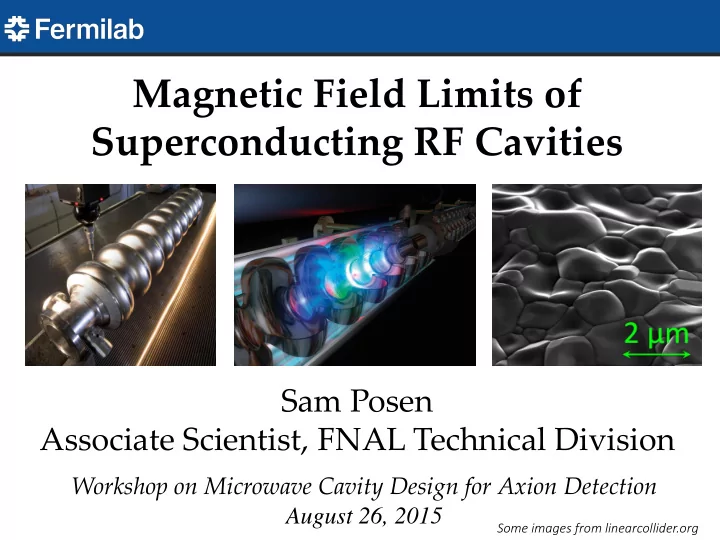

Magnetic Field Limits of Superconducting RF Cavities Sam Posen Associate Scientist, FNAL Technical Division Workshop on Microwave Cavity Design for Axion Detection August 26, 2015 Some images from linearcollider.org
Superconducting RF Cavities Liquid helium cooling Particle beam RF drive • Muscle of many large particle accelerators • RF input power accelerating electric field Image from linearcollider.org 2
SRF Accelerator Cavity • SRF cavity: high quality EM resonator • Particle beam gains energy as it passes through Input RF power at 1.3 GHz Slowed down by factor of approximately 4x10 9 • Electric field provides acceleration • Magnetic field can’t be avoided 3
Superconductors and Magnetic Fields • How high in field can we take SRF cavities? • State of the art niobium cavities are limited by peak surface magnetic field 4
Superconductors and Magnetic Fields • For relatively small applied magnetic fields, superconductors expel flux: Meissner state • At higher fields, Type II superconductors allow flux to enter in packets: Vortex state 5 Images from Wikipedia and Rose-Innes and Roderick, Introduction to Superconductivity
Superconductors and Magnetic Fields • For relatively small applied magnetic fields, superconductors expel flux: Meissner state Avoid flux penetration. At RF frequencies • At higher fields, Type II superconductors allow flux excessive heating to enter in packets: Vortex state 6 Images from Wikipedia and Rose-Innes and Roderick, Introduction to Superconductivity
Superheating Field (Note: Magnetization curve for H increasing only) Meissner M = -H state Meissner state (metastable) -M Vortex state H c1 H sh H c2 H • Flux free Meissner state is stable up to H c1 • Favorable for flux to be deep in bulk above H c1 • BUT surface energy barrier allows metastable state! 7
Superheating Field Why a superheating field? B applied λ : B-field decay constant ξ : Cooper pair interaction x distance Barrier Energy cost: creation of normal λ > x conducting vortex core Energy benefit: flux from high magnetic field region into low Costly core x enters first; magnetic field region gain from field λ later Slide adapted from J. P. Sethna 8
Selected Superconductors • NbTi (magnet quality): • Lots of pinning centers – H c2 ~15 T • T c ~9-10 K, ductile • Niobium (SRF quality): • Robust barrier to magnetic flux – H sh ~0.2 T • T c ~9 K, ductile • Nb 3 Sn (can be either!): • Can be made with pinning centers – H c2 ~ 30 T • Predicted robust barrier to flux – H sh ~0.4 T? • T c ~18 K, brittle 9
Fabrication of SRF Cavities • Used in accelerators: Pb and Nb, either bulk or sputtered • Many film deposition methods researched: ECR, ALD, CVD, HPCVD, MOCVD, HiPIMS, e- beam, thermal vapor diffusion, liquid diffusion, co-sputtering+annealing, cathodic arc deposition • Many alternative superconductors considered 10
Experimental Properties of Promising Materials Material λ (0) [nm] ξ (0) [nm] B sh [mT] T c [K] ρ n (0) [µ Ω cm] Nb 50 22 210 9.2 2 Nb 3 Sn 111 4.2 410 18 8 MgB 2 185 4.9 210 40 0.1 NbN 375 2.9 160 16 144 Parameters for: Nb from [1] assuming RRR = 10; Nb 3 Sn from [2]; NbN from [3]; MgB 2 from [4] and [5]. B sh for Nb found from equation in [6] and for others calculated from [7]. B c used to calculated B sh found from [8] eq. 4.20. [1] B. Maxfield andW. McLean, Phys. Rev. 139, A1515 (1965). [2] M. Hein, High-Temperature Superconductor Thin Films at Microwave Frequencies (Berlin: Springer, 1999). [3] D. Oates, et al., Phys. Rev. B 43, 7655 (1991). [4] Y. Wang, T. Plackowski, and A. Junod, Physica C 355, 179 (2001). [5] X.X. Xi et al., Physica C, 456, 22-37 (2007). [6] A. Dolgert, S. Bartolo, and A. Dorsey, Erratum [Phys. Rev. B 53, 5650 (1996)], Phys. Rev. B 56, 2883 (1997). [7] M. Transtrum, G. Catelani, and J. Sethna, Phys. Rev. B 83, 094505 (2011). [8] M. Tinkham, Introduction to Superconductivity (New York: Dover, 1996). Material parameters vary with fabrication . References were chosen to try to display realistic properties for polycrystalline films. 11
Multilayer Films • Alternative geometries considered, including multilayer SIS’ films studied in depth • No significant increase predicted for maximum flux-free field [Posen et al. 2013, Kubo et al. 2013, Gurevich 2015] 12 Images adapted from A. Gurevich, APL 012511 (2006)
Pulsed Quench Field Radio Frequency Magnetic Field Limits of Nb and Nb 3 Sn 13 S. Posen , N. Valles, and M. Liepe, PRL 115, 047001 (2015).
DC Flux Penetration Flux penetration See Nick Valles’s thesis, Cornell University, 2014 14
DC Flux Penetration See Nick Valles’s thesis, Cornell University, 2014 15
Q 0 -drop from DC Magnetic Field B DC = 0 T After B DC = 0.3 T 16 Raw data measured by Nick Valles, Cornell University, 2013
Takeaway • Realistic expectation: B max ~ 0.2 T at walls of superconducting cavity to maintain high Q 0 • Alternative materials may increase limit up to 0.5 T with a few years of development 17
Possible Workaround • Poloidal field coils • Large field in cavity interior • Smaller field at walls 18
Recommend
More recommend